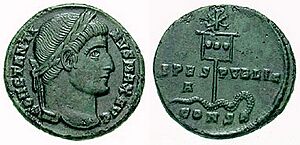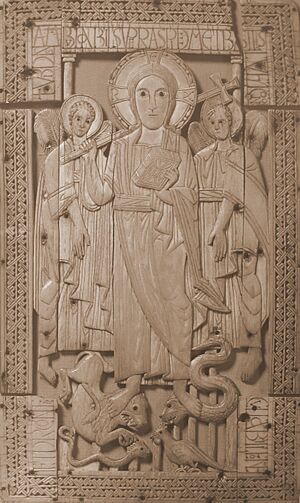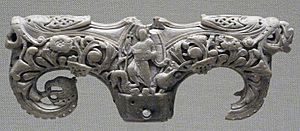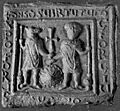Christ treading on the beasts facts for kids


The artwork known as Christ treading on the beasts shows Christ standing with his feet on animals. This theme was popular in early Christian art, especially between the 4th and 12th centuries. It's a special version of the "Christ in Triumph" idea, which celebrates Christ's victory after he rose from the dead. In these artworks, Christ often holds a cross-staff, which might have a spear-like tip at the bottom. Some art experts believe there's also a very rare, peaceful version called "Christ recognised by the beasts."
Contents
What Does the Image Mean?
The idea for this artwork comes from the Bible, specifically Psalm 91:13. In the Latin version, it says: "You will trample on the asp and the basilisk; you will tread on the lion and the dragon." This verse was understood by early Christians to mean that Christ defeats and triumphs over Satan, the devil.
Sometimes, the artwork shows two animals, usually a lion and a snake or dragon. Other times, it shows four animals: the lion, dragon, asp (a type of snake), and basilisk. These four animals were all seen as symbols of the devil. Important Christian thinkers like Cassiodorus and Bede explained this meaning in their writings about Psalm 91. This Bible verse was also sung daily in monasteries and on Good Friday, the day Christ was crucified.
The earliest known example of this artwork is a mosaic from the 6th century in the Archbishop's Chapel, Ravenna. In this mosaic, Christ looks like a general or emperor in military uniform. He is clean-shaven and has a halo with a cross. He holds an open book showing a verse from the Gospel of John: "I am the way, and the truth, and the life." His other hand holds a cross resting on his shoulder. This image was likely meant to show the Church's fight against a belief called Arianism, which questioned Christ's divine nature. The mosaic strongly states the traditional Christian belief. It shows a lion and a snake.
At first, Christ was shown standing still, as if resting on the defeated animals. Later, from the time of Carolingian art (around 800-900 AD), the cross he held sometimes had a spear-head. Christ might be shown actively pushing this spear into one of the animals, often the serpent's mouth. This more active pose was also seen in images of the Archangel Michael fighting Satan. In most early artworks, Christ is shown without a beard. Later, the animals often appear under the feet of a seated Christ in Majesty, a common image of Christ on his throne. Sometimes, only a single snake is shown being trodden on by Christ.
The more "militant" (fighting) versions of this artwork were especially popular in Anglo-Saxon art (art from early England). Some historians believe this was because Anglo-Saxon tribes enjoyed stories about heroes fighting wild beasts and monsters, like in the epic poem Beowulf.
Famous Examples
You can find the "Christ treading on the beasts" image in several important artworks from the Carolingian period onwards:
- An ivory relief (a carved image) from Charlemagne's "Court School." It's on the back cover of the Lorsch Gospels, a famous illuminated manuscript from about 810 AD. This one shows four beasts.
- The middle part of another Carolingian ivory book cover, known as the "Oxford book cover." It also features four beasts.
- Another Carolingian ivory relief from Genoels-Elderen in Belgium. This one also shows four beasts.
- The Anglo-Saxon stone Ruthwell Cross. This cross shows two animals that look like otters. Christ doesn't hold a cross here; his hands are together in front of him. This image is much debated by scholars.
- The Anglo-Saxon Bewcastle Cross, which has a very similar image to the Ruthwell Cross.
- An illustration for Psalm 90 in the Utrecht Psalter (a book of psalms) from the late Carolingian period. It shows Christ using his cross as a weapon against the serpent.
- The Stuttgart Psalter, from a similar time, shows Christ's cross ending in a spear-point, which is plunged into the serpent.
- The ivory head of an early 11th-century tau cross in the British Museum.
- The Crowland Psalter (mid-11th century Anglo-Saxon) shows Christ with a spear and two beasts.
- An end section of the shrine of Saint Hadelin, from around 1075, in Visé, Belgium. Here, a beardless Christ has one foot on the neck of each of two beasts.
- The "Errondo Tympanum" relief, made by the Master of Cabestany (1150–1175). It shows three figures of Christ (now bearded), each standing on a beast.
- A tympanum relief from around 1216 at the church in Strzelno, Poland. It shows two beasts beneath a seated Christ.
- A Gothic sculpture on the portal of Amiens Cathedral shows a standing Christ blessing, with two beasts.
Christ Recognized by Animals?
There's another way to understand the images on the Ruthwell and Bewcastle Crosses. Some scholars believe they show something even rarer: "Christ as Judge recognised by the beasts in the desert."
The main difference in this idea is that the animals don't represent the devil. Instead, they are real wild animals that Jesus met, especially during his forty days in the "wilderness" or desert after his Baptism. Scholars have found many old texts that describe wild animals becoming peaceful and submitting to Christ and other Christian figures. A famous example is the story of Saint Jerome and the lion. Later, Saint Francis of Assisi also had stories about his peaceful interactions with animals.
This idea has been accepted by many, but it's still debated. A few other examples of this "peaceful" subject have been found, mostly from before 1200. A very clear one is a 14th-century picture from Catalonia that shows a scene where Christ is tempted, followed by a scene where lions, bears, and deer sit peacefully in pairs as Christ blesses them. The words around the image on the Ruthwell Cross say: "Jesus Christ: the judge of righteousness: the beasts and dragons recognised in the desert the saviour of the world." This new interpretation would only apply to the two Anglo-Saxon crosses mentioned here, not to works like the Ravenna mosaic or the Carolingian book covers.
Other Similar Artworks
Over time, the idea of "treading" on devilish beasts was also used for saints. For example, an old artwork found near Vinica, North Macedonia, shows Saint Christopher and the warrior saint Saint George. They are stepping on two snakes with human heads, and both saints are aiming spears at the snakes' heads. This is one of the earliest examples of the dragon-slaying theme, which later became strongly linked to warrior saints like Theodore and George.
A well-known image of David in the Durham Cassiodorus (8th century) shows him holding a spear and standing on a snake with a head at each end. This snake is a mix of the different beasts. The book this picture illustrates explains that Psalm 90:13 refers to Christ. It also says that David is a "type" of Christ, meaning he represents Christ in some way. In later Anglo-Saxon books, the figure standing on a similar beast is Christ himself.
Another similar image might be connected to a different Bible verse, Psalm 74:13: "You divided the sea by your strength; you broke the heads of the dragons in the waters." This verse was linked to baptism. On the wooden doors of Sankt Maria im Kapitol in Cologne (1049), a scene of the Baptism of Christ shows Christ standing on some kind of sea-monster.
In a Romanesque artwork from around 1130, showing the Adoration of the Magi, Christ isn't there. Instead, the Three Magi walk to the Virgin and Child along the back of a dragon that looks like a bull. The Virgin Mary's throne sits on a lion. Both animals are lying down, and one of Mary's feet rests on each animal. Following ideas from the Book of Revelation, Bernard of Clairvaux called Mary the "conqueror of dragons." Mary was often shown crushing a snake underfoot, which also referred to her title as the "New Eve."
Images for kids
-
The Ruthwell Cross
-
Bewcastle Cross, West Face, showing John the Baptist, Christ treading on the beasts, and runes
-
Illustration of David as Victor from the Durham Cassiodorus.








